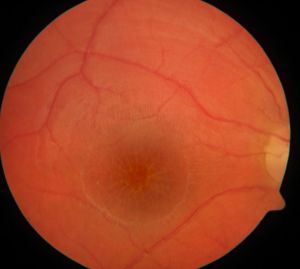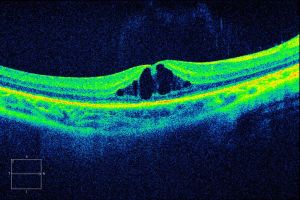WHAT IS X-LINKED RETINOSCHISIS?
X-Linked Juvenile Retinoschisis is an inherited eye disorder that makes the inner layer of the retina split in a spoke-wheeled pattern. It usually occurs in both eyes at once. This disease affects more males than females.

Boys with the condition may have symptoms in early childhood, but are often not diagnosed until they have their first visual screening before starting school. They usually have vision of 20/60 to 20/120, with tiny lesions, splits, or cysts visible on their retinas. Fewer than 10% of people with the condition experience full retinal detachment or bleeding inside the eye, both of which can cause blindness.

As boys with X-linked juvenile retinoschisis go through their teens, their vision may slowly worsen, but it typically stabilizes in their twenties. When they reach their forties and fifties, their vision may start to deteriorate again. Many people with the condition eventually have vision of 20/200 or worse, making them legally blind. Reference: www.counsyl.com
Other names for X-Linked Juvenile Retinoschisis:
- X-Linked Juvenile Retinoschisis
- Juvenile Retinoschisis
- X-Linked Juvenile Retinoschisis 1
- XLRS 1
- X-Linked Retinoschisis
- RS1
Additional information about X-Linked Retinoschisis can be found here:
Retina Australia
Kellogg Eye Center
The Foundation Fighting Blindness
About Health
Gentle Results
Genetics Home Reference
GENETICS
This condition is inherited in an X-linked recessive pattern. The gene associated with this condition is located on the X chromosome, which is one of the two sex chromosomes.
Click here for Inheritance Pattern
In males (who have only one X chromosome), one altered copy of the gene in each cell is sufficient to cause the condition. In females (who have two X chromosomes), a mutation would have to occur in both copies of the gene to cause the disorder. Because it is unlikely that females will have two altered copies of this gene, males are affected by X-linked recessive disorders much more frequently than females.
A characteristic of X-linked inheritance is that fathers cannot pass X-linked traits to their sons.
Additional information about Genetics can be found here:
TREATMENT
In general, treatment focuses on monitoring the progress of the disease and helping affected individuals learn to cope with poor vision. For example, children can use large-text books and high-contrast reading materials. Adults can purchase special magnifiers, clocks, and adaptive software to help them at home and at work.
Because X-linked juvenile retinoschisis affects only the inner layers of the retina, surgery is rarely effective in treating the disease. However surgery may help with complete retinal detachment.
Low-vision specialists such as optometrists can help both children and adults make the most of the vision they have. Some people with the condition can get restricted driver’s licenses if they wear special telescopic lenses behind the wheel. (Please note that these lenses are not legal in all states.)
Children under the age of 10 should see a pediatric ophthalmologist or retina surgeon every year. Older children and adults need less frequent monitoring.
People with X-linked juvenile retinoschisis should avoid high contact sports and other activities that might cause a hard blow to the head. This minimizes the risk of retinal detachment or bleeding in the eye. Reference: www.counsyl.com
RESEARCH
Ongoing scientific research is directed at identifying the gene that causes Juvenile Retinoschisis as the first step in developing means of treatment and prevention.
Medical journal articles related to the latest research of XLRS can be found here:
HOW TO LIVE WITH X-LINKED RETINOSCHISIS?
Information related to how to cope with X-linked Retinoschisis can be found here:
Retina Australia
Macula Vision Research Foundation
SUPPORT
Below are the links to the organizations providing disability care and support services to people with impaired vision.










